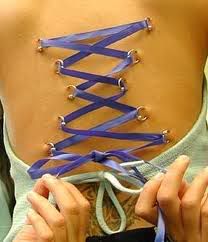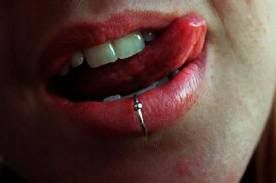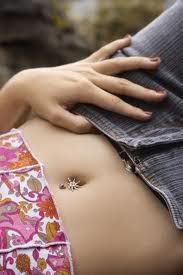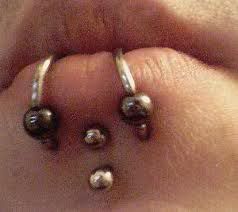 The most important thing to keep in mind after your body piercing has been performed is that you have essentially just sustained an open wound, and you should be caring for it exactly like you would a surgical wound or injury. That is, with the same kind of care, cleanliness and attention that you would to a serious injury to make sure that you don’t scar or get an infection. There are two different types of body piercings to consider: non-oral and oral.
The most important thing to keep in mind after your body piercing has been performed is that you have essentially just sustained an open wound, and you should be caring for it exactly like you would a surgical wound or injury. That is, with the same kind of care, cleanliness and attention that you would to a serious injury to make sure that you don’t scar or get an infection. There are two different types of body piercings to consider: non-oral and oral.
Non-oral body piercing aftercare
Keeping your piercing clean can’t be stressed too much! It just can’t. Twice a day, every day, without fail. No excuses. Use a mild antibacterial soap that doesn’t have fragrances in it, such as Provon® Antimicrobial Lotion Soap or Satin® Therapeutic Skin Cleanser, both of which are approved by the Association of Professional Piercers (APP). The best place to clean your piercing is usually in the shower, where the warm water will help you loosen and remove those crusties around the base of your jewelry. Use a cotton swab or a Kleenex to remove these, and then throw the swab or Kleenex away. Never use a washcloth –- these things are breeding grounds for germs and bacteria! The same for bath towels after your shower!
Then, with clean hands, gently cleanse the area with the soap and turn the jewelry so that the soap gets in the piercing and let this sit for a minute or two. After rotating it again, rinse thoroughly with warm, clear water. Make sure you get all of the soap out to prevent irritation. The rinsing is very important, so try to be thorough without irritating the area. It often helps to cup your hands and drizzle water over the area, since the shower stream can be a little too hard to aim directly on the area.
Don’t forget your sea salt soaks
 After cleansing, a sea salt soak helps to draw out any piercing infection and impurities while soothing the area and calming any inflammation that may be present. Mix about ¼ teaspoon of sea salt with 8 ounces of warm water. Using a disposable cup, soak your piercing in this for ten minutes the first time, and five minutes each time after that. If your piercing is in a location that makes this difficult, apply the solution with cotton swabs, tissues or some other disposable product that’s soft and clean. Never use a hanky, washcloth or any other item that is going to be reused.
After cleansing, a sea salt soak helps to draw out any piercing infection and impurities while soothing the area and calming any inflammation that may be present. Mix about ¼ teaspoon of sea salt with 8 ounces of warm water. Using a disposable cup, soak your piercing in this for ten minutes the first time, and five minutes each time after that. If your piercing is in a location that makes this difficult, apply the solution with cotton swabs, tissues or some other disposable product that’s soft and clean. Never use a hanky, washcloth or any other item that is going to be reused.
Always pat your piercings dry with cotton balls, cotton swabs or tissues –- don’t rub them, pat them. This reduces irritation and possible tearing of the skin and helps promote healing. Although it seems to be a minor step, keeping your piercings dry is actually an essential part of piercing aftercare because it reduces the opportunities for bacteria to breed (they love a warm, moist place to play).
If you aren’t sure about mixing your sea salt soaks properly or it’s too inconvenient, there’s a new alternative on the market that’s less messy and is portable. H2Ocean® Piercing Aftercare Spray is a pre-mixed sea salt solution containing lysozyme, a natural antibacterial that is gentle to the skin. Simply spray it on the area and allow to drip dry; it’s easy to use because of their patent-pending compressed air delivery system that produces a fine mist. This product is guaranteed to heal navel piercings in only a month and a half if used regularly and is highly recommended by numerous piercing communities like BME and Prick magazine.
H2Ocean® also comes in a portable size for your pocket or purse, which makes piercing aftercare away from home easier. X-pressions Piercing Aftercare Spray is also available for both oral and non-oral body piercings and is a mild antibacterial solution with purified water in a non-aerosol, pump spray with a pleasant, peppermint flavor.
Once a day (not more often, because you’ll be unnecessarily irritating the area), check that the ends of your piercing jewelry are firmly screwed on. But wash your hands with antibacterial soap first.
And now, a few “don’ts”
- Don’t ever put hydrogen peroxide or alcohol on a piercing -- they are too drying and will delay healing.
- Don’t ever use Neosporin on a piercing -- it can actually trap bacteria. Read the label; it actually says, “Not for puncture wounds.” Guess what? A piercing is a puncture wound.
- Don’t ever remove your piercing jewelry before the piercing is completely healed, which may take months or up to a year. If you suspect a piercing infection, see your piercing professional or doctor first.
- Don’t sleep on your piercing until the initial healing phase is over.
- Don’t wear tight clothing over your piercing during the initial healing phase.
Oral piercing aftercare
 During the first three to six weeks after an oral piercing, rinse your mouth with an antibacterial agent after every meal to kill bacteria and make sure not tiny food particles aren’t lodged around your piercing just waiting to fester and turn into problems later. There are several excellent products on the market for this, including APP recommended Biotene and Tech2000 Dental Rinse; these have the proper ingredients and have the right potency to get the job done without being too strong.
During the first three to six weeks after an oral piercing, rinse your mouth with an antibacterial agent after every meal to kill bacteria and make sure not tiny food particles aren’t lodged around your piercing just waiting to fester and turn into problems later. There are several excellent products on the market for this, including APP recommended Biotene and Tech2000 Dental Rinse; these have the proper ingredients and have the right potency to get the job done without being too strong.
Don’t bother with mouthwash, because it’s not strong enough to do anything but cover your bad breath, which won’t be much consolation when you have a swollen, tender tongue because of improper aftercare. You can also use a commercial antibacterial rinse, but dilute it so that it isn’t too strong. If your tongue develops a whitish or yellowish look, your mouth rinse is too strong and will slow healing.
Sea salt rinses … ahh!
Mix the familiar warm water solution of 8 ounces water to ¼ teaspoon sea salt and swish this in your mouth for 15-20 seconds after drinking anything other than water and after smoking. It’s not only an aid to healing, but can be very soothing to the pierced area. If your oral piercing is sore or swollen, you can find some relief by allowing crushed ice to melt in your mouth. Popsicles, ice cream and the like also work, but will need to be followed up, like everything else, with a sea salt rinse (or H2Ocean®).
Brush, brush, brush
You can keep your tongue and piercing as clean as you want, but if you don’t brush your teeth well, you’ll still have millions of bacteria in your mouth. Try to brush your teeth three times a day during the first several weeks of healing. Buy a new soft-bristle brush that will be gentle on your piercing. Don’t use a brush that you’ve already used before your piercing, as it will harbor old germs. You should also gently brush the balls on the ends of your piercing jewelry to prevent the natural build-up of plaque on your jewelry.
Oral piercing “don’ts”
- Don’t smoke, chew gum or use snuff or rub during the healing period; these increase the risk of piercing infections astronomically.
- Don’t play with the piercing jewelry or click it against your teeth; this can cause cracking of your tooth enamel.
- Don’t engage in any activities, including kissing, that exchange body fluids during the initial healing period of several weeks.
General tips to improve healing success
Proper piercing aftercare is the primary reason for a successfully healed body modification, but your overall health and how well you take care of yourself is also a contributing factor. If you are run-down or your immune system is compromised, you will not heal as quickly and you will be more prone to infection. For that reason, you should keep in mind a few things whenever you have any kind of piercing in order to help ensure that your piercing aftercare measures are given the best chance of success:
- Drink plenty of fluids, especially water. Eight glasses of day at the very least.
- At least eight hours of sleep a night
- Try to limit the amount of stress in your life
- Vitamin C and Zinc supplements to help speed the healing process
- Lots of fruits and vegetables, and a multi-vitamin if needed
- If the pain bothers you, take Ibuprofen. If you are comfortable, you are less likely to fidget with the piercing.
Signs of trouble
Even with excellent piercing aftercare, there will be some swelling at the site of a piercing for a few days. You’ll also have some clear, watery discharge and perhaps some mild bleeding. The bleeding will usually stop within 24 hours, while the discharge may last for several days or weeks. This is simply drainage of the wound and actually helps prevent piercing infection.
Signs that the piercing is in trouble include:
- Discharge that becomes noticeably thicker and is yellow or green in color. This is a sign or infection and should be checked by a doctor.
- Inflammation that lasts longer than a few days, with redness and irritation. See your piercing professional or doctor.
- Red streaks from the piercing site and a fever, along with body aches. See your doctor.
- Hives, redness, itching and irritation around the piercing, which may signal an allergic reaction to the piercing jewelry. Your piercing professional can try replacing it with an alternative metal.
- Difficulty breathing or wheezing after your piercing, or a feeling that your mouth or throat are swelling closed. Seek emergency attention immediately!
So how long does all this healing take?
 If you perform your piercing aftercare properly, your body piercing will heal cleanly and leave you with a beautiful new piercing with no scarring, migration or keloids. The time it takes to achieve this, however, will vary depending upon what kind of piercing it is.
If you perform your piercing aftercare properly, your body piercing will heal cleanly and leave you with a beautiful new piercing with no scarring, migration or keloids. The time it takes to achieve this, however, will vary depending upon what kind of piercing it is.
The general timeframes listed below are just for reference. All of these depend upon your individual body’s response, how much stress you are under and a thousand other variables.
Earlobe or Eyebrow: 6 – 8 weeks
Genitals: 4 weeks – 4 months ..
Labret/Lip: 6 – 8 weeks
Navel: 6 – 18 months
Nipple: 3 – 6 months
Nostril: 3 months – 1 year
Septum: 6 – 8 weeks
Tongue: 4 – 6 weeks
Cartilage: 3 months – 1 year....












![Validate my Atom 1.0 feed [Valid Atom 1.0]](valid-atom.png)
No comments:
Post a Comment